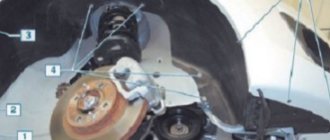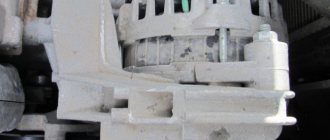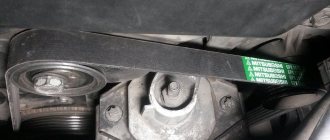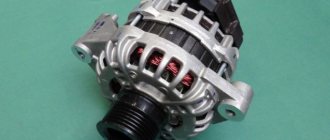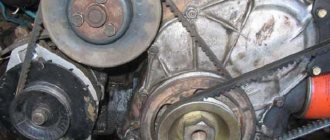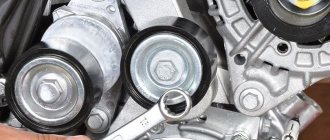In most cases, there is one reason for the appearance of a whistle, squeak, squeak or squeal from under the hood of a car - the alternator belt or timing belt is whistling. On modern cars, in addition to the generator, the drive belt can also rotate the pulleys of the power steering, air conditioning compressor, engine cooling pump and other attachments.
The reasons for whistling may vary. For example, a whistling alternator belt in wet weather can be caused by moisture getting on the belt and pulleys. And if the generator belt whistles when cold, this may be due to thickened lubricant in the generator bearings or tension rollers.
In this article we will talk about why the alternator belt whistles, what to do in such cases, and how to eliminate the drive belt whistle yourself.
The whistling may appear for a while and then disappear (for example, the whistling of the alternator belt when the engine is cold, during rain or when the air conditioner is turned on), or it may be constant. What to do and where to start looking for the cause of the whistle?
Why does the alternator belt whistle and how to eliminate the whistle?
In most cases, there is one reason for the appearance of a whistle, squeak, squeak or squeal from under the hood of a car - the alternator belt or timing belt is whistling.
On modern cars, in addition to the generator, the drive belt can also rotate the pulleys of the power steering, air conditioning compressor, engine cooling pump and other attachments. The reasons for whistling may vary. For example, a whistling alternator belt in wet weather can be caused by moisture getting on the belt and pulleys. And if the generator belt whistles when cold, this may be due to thickened lubricant in the generator bearings or tension rollers.
In this article we will talk about why the alternator belt whistles, what to do in such cases, and how to eliminate the drive belt whistle yourself.
The whistling may appear for a while and then disappear (for example, the whistling of the alternator belt when the engine is cold, during rain or when the air conditioner is turned on), or it may be constant. What to do and where to start looking for the cause of the whistle?
What should you do if you hear a whistle coming from under the hood?
We have listed all possible malfunctions in which the motor and its components may whistle when starting the engine or during its operation. To eliminate most of them, the car owner does not need to have any special professional skills. You can handle replacing many belts and rollers, tensioning them, as well as cleaning the elements of the intake system yourself. But if you are not sure that you can cope with such problems, then it is better not to delay them, but contact a car service center to the experts in their field and then you can avoid much more expensive repairs and a lot of unnecessary troubles that can overtake you taken by surprise.
The owners of the new Granta believe that the developers “messed up” with the exhaust system or engine assembly.
In a thematic community dedicated to LADA Granta LF, one of the owners of the new product complained about a strange defect. The motorist said that when the speed increases above 110 kilometers per hour, a “mysterious” whistle is heard from under the hood. Some commentators were jokingly surprised that the new Granta could even accelerate to such a speed.
“Why do we need Creta?”: The budget “Chinese” Haval H2 delighted the reviewer
The blogger reviewed the Chinese crossover Haval H2, which competes in the market with the Hyundai Creta and Suzuki Vitara, and told what impressed him with this car.
In general, motorists believe that first of all it is worth checking the oil level in the LADA Granta FL, as well as checking the serviceability of the exhaust system. All defects should be corrected exclusively by the dealer.
Others joked about the "Grants" problem. “It just has a hidden turbo engine, and that’s what whistles. An Easter egg from the developers,” said one of the “tank producers.”
Why does the generator belt whistle (reasons for whistling)
Many car enthusiasts believe that the whistling of the alternator belt appears only because it is worn out or sagging, but this is not entirely true. It is not always possible to eliminate whistling by replacing the old belt with a new one or “tightening” it. Often the causes of whistling may not be obvious.
In order to understand how to eliminate the whistling of the generator belt, you must first understand why it whistles (squeaks, creaks), and what are the reasons for the appearance of these sounds.
During operation, the alternator belt, like other vehicle drive belts, is subjected to prolonged high loads. With its help, torque from the engine crankshaft is transmitted to the generator and other attachments.
Most drive belts in automobiles are wedge-shaped, which provides greater frictional force where they contact the pulleys. They are called V-belts. The same belts that have several wedge-shaped tracks (so-called “rivulets”) are called poly-V-belts.
V-belts are available with and without teeth. It is believed that belts with teeth work better at breaking, do not break and slip less often.
Now we have come to the answer to the main question - why does the alternator belt whistle ? It's very simple - in 99% of cases, the whistle appears due to the friction of the belt on the pulleys and tension rollers as a result of slipping! That is, if the belt cannot turn the pulley of a generator or other equipment, then it simply slips, making an unpleasant sound similar to a whistle, squeak, squeak or squeal.
Therefore, you need to look not for the cause of the whistle, but for the reasons that cause the belt to slip. And there can be five main reasons:
- Weak or very strong alternator belt tension;
- Poor quality or worn belt;
- Getting dirt, moisture, oil and other technical fluids onto the belt and pulleys;
- Faulty generator bearing or tension roller;
- Pulley misalignment.
In addition, the appearance of a whistle can be influenced by such factors as humidity and ambient air temperature, the technical condition of the generator, air conditioner, power steering and other equipment driven by the generator belt.
Possible causes of belt noise and howling
In fact, such a problem, when drivers do not know why the noise appears when the engine is cold when starting the engine or after replacing the timing belt, is common. Next, we will try to answer why the belt whistles and what it might be connected with. So, why does the timing belt whistle after replacement and why does the noise occur when the engine is started cold? There are several reasons for this:
- The first and most common reason is element wear. The whistling of the timing belt is typical for those elements in which the teeth have already worn out and which slip when the pulleys rotate. In this case, it is quite possible that it will quickly fail, that is, the strap will break. If you want to avoid the problem of the element breaking in the future, then it is advisable to replace it with a new one. Sometimes in this case, additional tension of the component can help, but, as a rule, it only eliminates the whistling problem, but if the element is already worn out, then nothing will help it except replacement.
- The belt also often whistles after replacement if liquids get on it. If the noise appears when the engine is cold when starting or after replacement, then this may indicate to the motorist that there is a leak in the engine or coolant. In principle, it can be any liquid, not just oil or antifreeze. Perhaps the brake fluid also got on the element for some reason. In addition, consumables may end up on the disk of one of the pulleys. It is necessary to eliminate the cause of the leak, and then also replace the component.
- If noise appears immediately after replacement, this may indicate that the quality of the element is too low. Perhaps you purchased it for little money and the strap is of low quality. Nothing will help here except how to change the element. Of course, it can work for a certain time and not whistle if it is lubricated. But in this case, it should be periodically diagnosed in order to prevent its breakage in time.
- Also, one of the common reasons why noise appears after replacement is wear on the tension rollers. Perhaps they have simply reached the end of their service life and it’s time to replace them. Most likely, nothing will help in this case other than replacing the part.
How to eliminate a whistling alternator belt
You can get rid of the generator belt whistling by eliminating the reasons that cause it to slip on the pulleys.
If there are signs of belt slipping, accompanied by an unpleasant whistle, we suggest eliminating it in the following order:
- Stop the engine, open and secure the hood to prevent it from closing spontaneously;
- Carefully inspect the alternator belt without removing it from the car. There should be no tears, protruding threads or other visible damage on its surface. If they are detected, the belt must be replaced with a new one.
- Both the inner and outer sides of the belt must be dry and clean, without traces of dirt, oil and other vehicle technical fluids. The same applies to pulleys.
- Check the degree of belt tension - in most cases, the cause of a whistle from under the hood is precisely the weak tension of the generator belt. We wrote about how to properly check the tension level of the alternator belt here.
For information on the optimal degree of tension of your car's alternator belt, refer to its operating instructions.
- If necessary, adjust the belt tension. A good video instruction for adjusting the alternator belt is at the bottom of this page.
- If all of the above did not help and the alternator belt continues to squeak obnoxiously, then with the engine running and good lighting, carefully inspect the line of pulleys for alignment.
An indirect sign of pulley misalignment is the poly V-belt jumping from track to track and sliding off the pulley.
- Pay attention to the linearity of rotation of the pulleys - if any pulley rotates in a figure eight, it will tear and throw off the belt. Most often, pulleys with a rubber damper behave this way, which over time loses elasticity and ceases to perform its functions.
And so, if the generator belt has not stopped whistling, but it is intact, clean, well tensioned, and the pulleys rotate smoothly and smoothly, then you can try to correct the situation using another method:
- Remove the alternator belt and carefully inspect it again for damage and dirt. If the belt is intact, then you need to clean its surface from the inside and outside (you can use gasoline or kerosene); if damage is found, buy a new belt.
- With the generator belt removed, thoroughly clean the pulleys from dirt and dust. This is best done with a wire brush. You can also use gasoline or kerosene.
- Place a clean belt on the clean pulleys and adjust its tension. After this, the whistling of the alternator belt should disappear.
If all of the above did not help and the belt whistle has not gone away, then the problem lies either in the quality of the belt itself or in the equipment that is driven by it: tension rollers, generator, power steering pump, air conditioning compressor, etc. Perhaps the grease in the bearings has simply thickened or they have failed, or perhaps the reason is much more serious, so in this case it would be better to seek help from a car service specialist.
You can try to temporarily eliminate the whistling noise using special auto chemicals, so-called conditioner-tensioners for drive belts. This, of course, will not solve the problem, but the whistling will disappear for a while.
Signs and consequences of the problem
The belt is the weak link of any transmission. Constantly rotating between the pulleys and transmitting torque, the element gradually wears out and its tension begins to weaken. Over time, slippage and accelerated abrasion of the rubber product occurs, leading to its breakage. Engine oil or coolant (or both) that has gotten onto the working surface can loosen the belt prematurely.
When it is necessary to check and tighten the belt drive:
- It is worth checking the belt at every opportunity when you open the hood of the car. On the vast majority of machines this will not be difficult - just reach out and press on top of the rubber product.
- If when the engine is running, especially after pressing the accelerator pedal, a loud, unpleasant squeak is heard from under the hood. The sound clearly indicates the belt drive is slipping on the pulleys.
- You should check the tension of the alternator belt when the red battery charging indicator on the dashboard periodically lights up.
- After disassembling and repairing the power unit, which involves removing this unit.
Slipping or breaking the belt does not have fatal consequences, but significantly reduces the battery life. When the generator shaft rotates intermittently or does not rotate at all, the on-board network receives voltage from the battery. Since decent power is needed to spark and power the systems, it discharges to zero quite quickly. Restoring the charge of a completely dead acid battery is quite difficult, and often impossible.
On some car models, a belt drive is used to rotate several pulleys at the same time - the generator, power steering pump, air conditioning compressor and water pump. Consequently, its slippage or breakage will affect the operation of these units. The danger is that the pump stops (the engine may overheat) and the power steering pump - the driver will not have time to adapt to the sharp increase in load on the steering wheel and may get into an accident. Therefore, it is better to check and tighten the alternator belt in a timely manner.
How to eliminate a whistling alternator belt?
Having identified the cause of the problem, begin to eliminate it. If there is mechanical damage to the transmission (chips, cracks), it will have to be replaced. Select consumables that are suitable for a specific car brand.
If the consumable is contaminated with working fluids, you can limit yourself to cleaning the unit, then install it in its original place. Don’t forget about the tension level of the gear - if it is not enough, you need to tighten it. If the pulleys are misaligned, they must be adjusted. And if it is determined that the bearing is to blame, the solution is to replace the element. The problem of a jammed tensioner or overrunning clutch can only be solved by repair at a service station.
In winter, the belt drive tightens, which also leads to the appearance of extraneous noise. There is no need to be afraid of this - after some time after starting the engine, the unpleasant sound will disappear. As part of prevention, it is worth applying special additives to the surface of the assembly.
There are many ways to solve the problem of alternator belt whistling - with proper diagnostics, it is not difficult to eliminate it. Open the hood more often - monitor the “health” of your car.
Any more or less experienced driver is able to determine a malfunction from inside the car only by sound. This is not a special talent and not an absolute ear for music. It's just an experience. Although an ear for music also has a certain importance, and in the issue that concerns us today, it is perhaps decisive.
Any experienced driver can detect a car malfunction by ear.
We determine the malfunction by sound
Every hum, whistle or hiss coming from under the hood has its own overtones. At the same time, each material and each operating material has a spectrum of sound waves that are easy to identify. For example, the knock of metal on plastic can never be confused with the grinding of tin on tin. These simple sounds are not described in any textbook and are not stored in any database. But they are easily identified with experience.
A leaking exhaust manifold gasket sounds much different than a blown main exhaust line gasket. The hissing, which is caused by a loose fit of the air filter housing to the carburetor in the VAZ 2107, has completely different overtones than the hissing of the intake manifold gasket. Still, the champions in terms of piercing sounds that pester drivers are the drive belts of the generator, power steering, air conditioning and the bearings of these devices. Why the alternator belt whistles, and whether it is actually a belt, we will figure it out together.
Video tutorial on how to get rid of alternator belt whistling during a cold start
In which ear?
“Tell me, dear child, in which ear I have a buzzing...” The monumental phrase of Faina Ranevskaya is more relevant than anywhere else in this case. Because whistling can, indeed, be heard in “both ears.” It may not be the alternator drive belt at all, there may be many reasons, but first you should understand the nature of the whistle under the hood, only after that you can draw some conclusions.
The cause of any whistle in V-belt drives of cars can only be friction. It doesn’t matter what interacts with what, if a whistle occurs, it means that one of the surfaces, or maybe both at once, has lost its original properties and physical characteristics. The characteristics of belts, bearings, and pulleys are influenced by a lot of external factors:
- air humidity;
- working temperature;
- natural wear and tear;
- mechanical damage;
- presence of lubricant in bearings;
- technical condition and adjustment of V-belt or toothed belt drive.
Preventative maintenance of the timing belt and tension pulley - all about fret repair - Website about
The article will discuss the causes of timing belt whistling and ways to eliminate this problem.
Where to look for the source of noise?
Many car owners are faced with such a problem as a sharp whistle (squealing) from under the hood when the engine is running. It can appear both when the engine is “cold” and when the engine is fully warmed up, under different loads.
Usually everyone starts to blame the occurrence of such a problem on the generator and its belt.
At the same time, they do not pay attention to the second belt drive - the gas distribution mechanism
But the appearance of a whistle in it is a more dangerous problem than in the drive belt of attachments.
Many people do not look for a problem in the timing belt for one simple reason - to ensure full transmission of force from the crankshaft, a belt with a toothed working surface is used. And the presence of teeth eliminates the possibility of slipping on the pinion and gear.
And since there is no slippage, then a squeal under the hood (one of the signs of increased friction between surfaces) cannot appear. The same cannot be said about the attachment drive belt.
To transmit force to the generator and other elements, a V-shaped or multi-ribbed belt without any teeth is used. That is, it is quite capable of slipping along the pulleys, which is why they are looking for the cause of the whistle primarily in this drive element.
- But many do not take into account that the timing belt transmits force not only to the camshaft, but also to the water pump.
- In addition, in order to prevent the teeth from jumping over the gear, the drive must be well tensioned, and for this purpose a tension roller is added to the design.
- And engines with two camshafts often use another roller - a bypass roller, also known as a parasitic roller.
- That is, it turns out that the timing drive additionally contains a number of elements, which often cause the appearance of uncharacteristic noise.
In general, if sharp third-party sounds appear when the engine is running, you should look at all drive belts
Since the generator drive whistles more often, you should pay attention to it first.
The main reasons for the appearance of third-party sounds in the timing drive
In general, it is not difficult to find out which drive has problems. It is enough to remove the alternator belt from the car and start the engine.
- A squeak that disappears or continues to sound will let you know where to look for the cause.
- If there is a squeal even with the belt removed, there is definitely a problem with the timing drive.
- To more accurately identify what exactly caused it without any disassembly, you can use a technical phonendoscope.
- Using it, you can identify the area where the sound occurs, which will allow you to immediately determine which of the elements is faulty after sampling.
- There are not so many main reasons for timing belt whistling:
- The belt itself can make sounds. If it is extremely worn, made of low-quality material, and not tensioned enough, then passing through the rollers (and it contacts them with a smooth surface), it will slip, making unpleasant sounds;
- The rollers may squeal due to the belt being tightened;
- Technical fluids (oil, antifreeze) have come into contact with the drive. As a result, they act as swarms of lubricant, reducing friction between the surfaces of the rollers and the belt, which causes slippage;
- Bearing wear. To ensure ease of rotation of the rollers and pump, bearings are installed in their design. If these elements are extremely worn out or there is insufficient lubrication, then increased friction occurs in them, accompanied by a squealing sound;
- Carelessness in carrying out work to replace the belt, resulting in the bending of the axis of one of the rollers. This leads to the fact that the position of the roller changes slightly, and due to a slight misalignment, the friction between the drive and the tension or bypass element increases.
POPULAR WITH READERS: How to check the starter, useful tips
Each of the reasons has its own characteristic features. For example, if you use a belt made of low-quality material that does not have sufficient elasticity, then in winter the rubber will “tan” after being parked in the cold.
- As a result of this, the drive element will be the cause of the “cold” whistle, which disappears after heating.
- As the temperature rises, the belt becomes more elastic and friction disappears.
- Approximately the same thing happens when technical fluids get in, but in this case the sound may last longer (until the oil or antifreeze rubs in).
- But wear of the bearings or bending of the roller axis is accompanied by a squealing noise in all modes of engine operation and under any temperature conditions.
Whistle when starting the engine when cold
A whistle under the hood when the engine is cold when starting can indicate several problems, and it can occur as a result of the belt slipping on the pulleys. What happens is that when starting the engine in cold weather, the grease in the generator bearing can thicken to such an extent that the belt is unable to turn the generator pulley and simply slips. This may be due to improper selection of bearing lubricant, belt wear, or insufficient belt tension.
If after the engine warms up the whistle disappears, this is exactly the case we are talking about. Changing the lubricant and checking the belt tension solves this problem in 99% of cases. Just first you need to make sure that the generator pulley rotates at all. There are times when the generator shaft jams, and then dismantling it is inevitable - you will have to change the shaft bushings or bearings, depending on the design of the generator.
The working surface of the generator pulley is also of great importance. It wears out extremely rarely, but in those cars where the generator pulley is exposed to all winds, where the generator is located below the level of the crankshaft pulley (Suzuki Vitara, Renault Logan, Mitsubishi Galant, Lancer 9), you can quite expect a jammed pulley, especially when it comes to SUVs - Niva, Mitsubishi Pajero, Suzuki Jimny. Although the Jimny, even in the stock version, provides quite serious engine protection - the car, although small, is as reliable as a tank. In the case when the car has a toothed belt drive of the generator (Opel Vectra 16 class, BMW, and other models), there is nothing to blame for the pulley. It's all about the bearing.
Engine whistling when starting and running
It's always nice to know that your car is in full working order and will not cause inconvenience at the most inopportune moment. However, this does not always happen and many car owners are faced with a number of manifestations of failure of some car parts. This makes people doubt their “iron horse”, and such a car will clearly not add positive emotions. The most common signal of a breakdown is a whistle when starting the engine. Moreover, it is faced not only by owners of old cars, but also by practically new ones that have recently left the dealership.
The reason why a whistle is heard when the engine is running can be a number of different malfunctions in the car engine. Usually this is not so much a dangerous sign as it is annoying. Although, if the engine begins to make such extraneous sounds and the engine whistles more and more, then it is clearly impossible to delay the elimination of this problem. Some ignored faults can lead to expensive repairs and a host of problems.
Alternator belt whistles in the rain
Fog, high humidity, rain are ideal conditions for the V-belt drive to whistle. For obvious reasons, moisture gets on the surface of the belt and reduces the frictional ability of the material, as well as on the pulleys. Wet whistles are short-lived, but you shouldn’t relax. This means that the belt has already begun to lose elasticity and should be tightened if wear allows.
In wet weather, the frictional abilities of the alternator belt material are reduced
In any case, belt slipping indicates a malfunction in the belt drive, and rain or splashes are simply an indicator that the belt may need to be replaced soon. To avoid such problems, let the small, cunning Americans from the Hi-Gear company come up with a remedy that can temporarily save you from whistling. Let's say a few words about him.
Briefly about the causes and ways to eliminate them
If the belt begins to whistle when starting the car engine when cold, this is evidence that it is slipping. Inspection required. It is worth checking both the cleanliness and absence of cracks, and the tension level. A dirty, oily strap with a cracked working surface must be replaced. Dirt getting on the strap causes rapid wear not only of it, but also of the pulleys.
A clean product with a margin of service life is still suitable - just tighten it up if the system allows it. If this is not the case, then only installing a new one will help. The whistle appeared after a recent replacement - the belt was not tightened. Tightening does not help - either the pulleys are worn out, or the rubber product is not original. In special cases, a skewed tensioner is to blame for the squeak.
Many faults in a car can be determined by sound. When some extraneous noise appears in the form of an incomprehensible knock, grinding, howling or whistling, this may indicate a breakdown of one of the car components. Some malfunctions are quite easily eliminated along with accompanying symptoms in the form of annoying and disgusting sounds. But there are certain signs of breakdowns that appear most often. Most often, a whistle is heard when starting the engine, which can be caused by a number of factors. Moreover, similar unpleasant sounds can occur even when the engine is already running. Next, we will talk about the causes of such phenomena and ways to eliminate them.
Chemistry against noise
In those distant times, when auto chemicals were almost a fantasy, they also struggled with whistling. And with the most ingenious methods. Despite the fact that the belt cost a penny, they tried to save it by any means necessary. The most popular, which you can, by the way, take note of, was the method of impregnating the belt with rosin. Regular rosin for soldering. It was dissolved in alcohol and the belt was treated with this solution. For some time, the belt became silent, since the rosin helped to increase the coefficient of resistance to slipping, the belt became more elastic, did not crack and tear so quickly, and in general, it lasted longer.
The Hi-Gear Belt Dressing aerosol offers something similar. The price of such joy is about 350 rubles, but it will not fundamentally solve the issue. The purpose of the spray is to give the belt elasticity and an aesthetically pleasing appearance (which the spray does better). Ideally, the new belt is treated with the solution before installation, but the instructions say that the life of the old belt will last twice as long with periodic use. The spray can be used for both V-shaped and serpentine belts. Chemical means can actually improve elasticity; the belt will not crack and dry out. This is not a panacea, but the beauty of the tool is that with its help you can find out exactly what is whistling - the belt or the bearing.
Belt whine when turning on the air conditioner
This whistle is more unpleasant because the alternator belt may have nothing to do with it. Although, given the changing load on the generator, it is quite possible that the belt slips along the pulley under load. The probability is small, but it is there. In this case, you just need to tighten the belt and the whistling should stop. If the whistle remains, the problem is in the air conditioning compressor, and the whistle is most likely the air conditioning compressor clutch drive belt.
It may not always be the alternator belt that whistles when the air conditioner is turned on.
There is very little pleasant here, since the minimum that you have to do to eliminate the noise is to change the oil in the compressor (depending on the design of the air conditioner - Kia Sid, Kia Rio, Hyundai Accent, Tuscon). In some cases, the compressor drive clutch may slip - due to the lack of the required amount of freon, the compressor lacks lubrication and, naturally, it is more difficult for it to spin. This also affects the load on the electromagnetic clutch. You can also try lubricating all the compressor bearings and the bearings on the pulley, again depending on the design of the air conditioner. If all else fails, replace the compressor or electromagnetic clutch.
Varieties of whistling
It is customary to distinguish whistling by the nature of its occurrence. For example, a whistle may appear only when cold, then disappear
Therefore, it is equally important to know how the alternator belt whistles
Whistling when cold is a common headache for Russian car owners. There are several reasons.
- The grease for the generator bearings is incorrectly selected. Because of this, in cold weather the composition becomes denser, the pulley cannot easily rotate the rotor. Everything goes away as soon as the engine warms up and the lubricant “defrosts”. The solution to this problem is simple - replace the anti-adhesive with a composition that is more cold-resistant.
- Weak belt tension. An engine that is simply not able to start working dynamically “when cold” requires time to warm up. During this period, a weakly tensioned belt lacks the strength to “accelerate” on the pulleys. It slips and whistles, but only until the motor begins to rotate quickly and evenly.
- The pulley itself is jammed. This also only happens “when cold” until the car parts are properly heated. You can check whether the pulley is the cause of the whistling yourself. You need to turn the generator pulley by hand, first taking off the belt. If the pulley rotates slowly or cannot be turned at all, serious repairs and even replacement are needed.
Another option for whistling is noise that occurs only when the engine is under load. This type of whistling is mostly caused by weak belt tension.
Belt whistling: reasons
| CAUSES OF WHISTLING | WHY IS IT WHISTLING? | WHAT TO DO |
| Generator belt | It becomes unusable due to natural wear and tear. Due to grains of sand that fell on the surface of this belt and ate into the grooves. | Check the condition of the belt; if there are cracks on its surface, stuck grains of sand are visible, or threads are sticking out, replace the generator belt immediately. |
| Poor tension | Often, after replacing the alternator belt, it is not tensioned well, resulting in the alternator belt whistling during loads, as well as in wet weather. | Tighten the belt. |
| Pulley or pulleys | If there is wear on the pulleys or they have been changed (installation of non-original pulleys is fraught with whistling and other problems), the appearance of whistling is quite understandable. A loose fit of the poly V-belt to the grooves on the pulley impairs adhesion, as a result the generator belt begins to slip and whistle. | Replacement or repair of pulley(s) |
| Liquid got on the belt | Often the generator belt whistles due to liquid (antifreeze, oil, fuel, etc.) getting on its working surface. | Check for oil and coolant leaks. Eliminate them. Replace the belt. |
| The generator bearing or tension roller is faulty | You can check whether there is play in the generator bearing only by removing it, or try to shake the generator pulley; in this case, the location of the generator plays a big role. | Replace the bearing. If the tension roller is faulty, it will also have to be replaced. |
The operation of cars, both domestic and foreign, is sometimes accompanied by an unpleasant whistling sound. The generator drive belt whistles. This phenomenon occurs more often in cold or rainy weather, when the engine is not warmed up.
It is possible to operate such a vehicle, but the whistle means that the drive is slipping on the pulleys without rotating the generator shaft. Accordingly, the battery does not receive the necessary charge.
The problem may be caused by other, more serious reasons. Why does the alternator belt whistle? What is the problem and what needs to be done to fix it?
General recommendations for finding the causes of noise
There can be a lot of reasons for the whistling noise, some of them are to blame for the belt itself, some are due to other components and parts, and as you can see, the list of faults is impressive. Summarizing all that has been said, let us give some general recommendations that will save your ears and, possibly, the engine from damage.
As soon as the whistle makes itself felt, first of all you need to:
- check the condition of the belt - if the belt is new, installed a week ago, and the whistle constantly appears after replacement, it is not a fact that the belt is of high quality, even a brand new one can whistle;
- The degree of belt tension must be checked - 90% of all problems with whistling are removed after adjusting the tension or lubricating the tension roller;
- It is worth paying attention to the alignment of the pulleys, to a greater extent this applies to VAZ 2110, 2109, VAZ 2112, as well as cars where the generator has a stamped belt tension bracket - Daewoo Nexia, Lanos, Matiz;
- Cleanliness of the surface of the belt and pulleys is an indispensable condition for the normal operation of the belt drive, and drops of antifreeze and oil can cause the belt to slip.
Causes of problems
If you have encountered a similar phenomenon, you have probably noticed that the belt begins to make an annoying squeak at moments of greatest load. The whistling sound accompanies the friction of rubber on metal as a result of slipping of the belt drive. In 90% of cases, this indicates wear of the belt, which is a consumable item and needs to be periodically replaced (interval from 20 to 60 thousand km, depending on the make of the car).
Now more about the reasons for slippage:
- Stretching during operation, loosening of tension. The element begins to sag, and when the load increases, it begins to squeak.
- Critical wear of the belt: the working surface becomes covered with cracks, threads come out on the sides, it is impossible to achieve normal tension.
- You purchased and installed a “consumable” made of low quality rubber. Such products quickly stretch, and the working surface is “licked”.
Practice shows that low-quality products and fakes whistle even at maximum tension. As experienced drivers say, the material contains more soot than rubber.
Whistling often occurs for other reasons that do not depend on the quality and technical condition of the belt:
- water or one of the process fluids - antifreeze, oil - has come into contact with the work surface;
- the bearing of the generator or tension roller has worn out and started to jam;
- non-original poly V-belt transmission pulleys are installed, whose grooves do not fit well with the belt profile, which is why it does not fit tightly to the surface.
In the design of some cars (for example, Chevrolet Niva), a belt drive additionally rotates the shafts of the air conditioning compressor, water pump and power steering pump. If the oil seal or bearing of any of the listed units fails and lubricant gets on the pulleys, the belt will begin to slip and squeak.
Other reasons
In addition to the main reasons, it is customary to take into account additional ones:
- The tensioner roller is another reason. For some reason, many people believe that it is eternal, but this is not so. If the roller fails, then expect problems, including a broken belt. After replacing the roller everything returns to normal.
- Another common case is when the fixation of the generator and power steering becomes loose. The fastening cracks due to something and the belts begin to tear. It could also be the gene bracket. It becomes crooked for some reason and problems arise.
- The reason is trivial - lack of generator protection. If it is not there, then everything that the headwind brings will begin to fly into the belt - stones, debris, branches.
How to replace the alternator belt
- It often happens that a gene jams (on-board voltage drops) or a pump. You can check the gene lock using a voltmeter, and the pump lock - by testing the engine temperature readings.
- Automotive electrics are directly connected to the generator. Heater, headlights, emergency lights, multimedia system, wipers, etc. If the car owner does not treat the electrics with care (do not turn on several consumers at the same time), then under heavy load the gene will begin to rotate tightly, and the belt, accordingly, will turn.
If the alternator belt breaks, then the cause should definitely be determined. But how to do this if there are quite a lot of them. First of all, experts recommend looking at the wear side. Depending on whether the belt is worn on the side of the streams or the smooth plane, appropriate conclusions can be drawn. In other words, it is on this side that it rubs.
Whistle when starting the engine
When one or more of the above problems occurs, the first thing that appears is the whistling of the alternator belt when the engine is cold. This happens for the following reasons:
- Cooled lubricant thickens and becomes viscous (especially in winter), so more force must be developed to turn the generator shaft. A loose or worn belt will slip and squeak at this moment.
- If the drive rotates the power steering pump, compressor and pump, then the resistance of the thickened lubricant increases. A small amount of sagging or liquid getting on the pulley is enough for the belt to start slipping.
- At the time of startup and the first minutes of operation of the internal combustion engine, an increased load is placed on the generator. The electromagnetic field of the stator creates resistance to shaft rotation.
A “cold” squeak is the first symptom of a belt drive malfunction. If you do not diagnose the problem and do not take measures to eliminate it, the drive will begin to squeak even on a warm engine, when you press the gas pedal.
Generator characteristics
Lada of the latest generation
The standard installation requires the presence of model 5102.3771, which is produced in Russia, which has a built-in rectifier unit and an electronic regulator for voltage during right rotation (on the drive side). The advantage of a generator of this brand is that it provides increased current output at low speeds (4-6 A when reduced to 300 rpm), which is a positive quality for traveling by car in winter. In addition, this feature of operation allows it to be equipped with an automatic transmission.
The technical characteristics of the generator 5102.3771 are as follows:
- weight - 5.41 kg;
- the gear ratio of the engine and generator on the Priora is 1 to 2.4;
- specific power - 205 W/kg;
- the maximum current output at 14 V is 80 A;
- adjustable voltage - from 13.8 to 14.4 V.
Troubleshooting
Next, it’s worth considering what the owner of a car with a whistling alternator drive belt should do. It is recommended to immediately inspect the mechanism and find out whether it is possible to continue moving or whether it is necessary to immediately begin repairs. Diagnostics is performed as follows:
- Open the hood, remove the plastic protective cover from the engine (if it is in the way) and carefully inspect the belt drive for water or process fluid. It happens that the drive gets wet after driving through deep puddles.
- If an oily liquid is found, not only on the belt, but also on the cylinder block, try to find its source. Carefully inspect the pump, power steering pump and air conditioning compressor - all units located next to the drive.
- When inspecting, pay attention to the engine gaskets so that oil does not leak from under them.
- Make sure that the belt is not cracked and that there are no threads on the sides.
- Check the tension using the vehicle's operating instructions. A universal method is to rotate the free section of the belt around the longitudinal axis. The tension is considered satisfactory when the element rotates no more than 90°.
If none of the above methods brings results, you will have to look deeper - loosen the drive belt and remove it from the pulleys. Then try rotating each pulley by hand, the goal is to detect any sticking in the shaft that is causing the belt drive to slip. If everything is in order here, carefully examine the working side of the strap - the “licked” surface will make it clear that you received a low-quality product.
Important point! Leakage of antifreeze from the pump, lubricant from the engine or power steering pump is considered a serious malfunction. After detection, you can only go to a garage or car service center, where repairs will be made.
Remedies
Finally, a few words about how to eliminate the whistling of the alternator belt. The method depends on the cause of the malfunction:
- a worn element, covered with cracks and unable to be stretched, should definitely be replaced;
- If water or antifreeze gets in, wipe the drive parts thoroughly;
- traces of liquid lubricants must be removed with a rag moistened with a degreaser, and it is recommended to remove the belt in order to wipe the pulleys;
- a loose belt drive should be tightened.
Before removing traces of operating fluids from drive parts, it is necessary to eliminate the cause of their leakage, otherwise such work is pointless.
The leaking pump is replaced entirely, and a new oil seal is installed in the power steering pump. If the generator bearing is found to be seized, the unit will have to be dismantled and taken to an auto electrician for restoration. A belt with a “licked” surface can be briefly extended its service life using the old-fashioned method. Take a piece of soldering rosin and rub the work surface thoroughly. The procedure is performed at idle speed of the engine, observing safety measures: rosin is applied to the inside of the rotating belt. After the operation, the element will acquire adhesion to the pulleys, allowing you to drive without whistling.
Source
